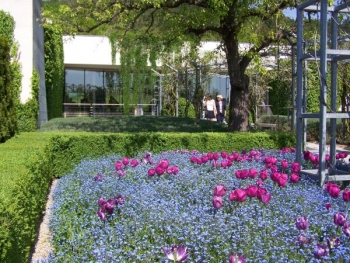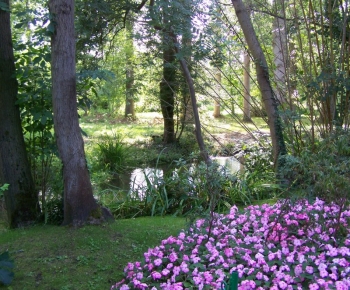Entries from September 2008
September 23, 2008
Next year, there will be a museum of Impressionism at Giverny.
The Museum of American Art Giverny located next Monet’s home at Giverny is living its last weeks.
Founded in 1992 by wealthy American collector Daniel Terra, the museum has exhibited American Art till now. Its visitors are mainly French individuals. They discover the Art History of the US, which is not well known in France.
But Foundation Terra will stop ruling the museum next year. The local county administration, the Departement de l’Eure, will deal with the new museum.
To what one can figure out as the public delight, the museum will be devoted to Impressionism. It makes sense on the very spot where Monet, the impressionist leader, painted so many masterpieces, and where hundreds of impressionist painters gathered to create Giverny artists colony.
The Musée de l’Impressionnisme of Giverny will have a famous partner: musée d’Orsay of Paris, a museum that owns the french state collections of paintings from the 19th century – dozens of works by Monet, Renoir, Cézanne, Pissarro, Sisley, Morisot…
Next year some of its best canvases will take a short trip to Giverny, 80km west of Paris.
The exhibition opening on 1 April 2009 will be dedicated to the most popular theme one could expect in Giverny: Monet’s gardens. It will certainly be a fantastic exhibition.
Posted in Giverny 1 Comment »
September 12, 2008
Claude Monet had calculated that the light changes every seven minutes in Giverny. I wonder if he didn’t exagerate a little bit, but he had an exceptional eye and he wanted to render the slightest light changes exactly.
Monet painted in series. He chose a spot he liked in his garden, a special framing of his pond, and he painted it over and over again.
That is to say he had several canvases on work, sometimes ten, sometimes up to twenty. He gave a few brushstrokes on one, then he noticed that the light was changing. He would look among the unfinished canvases to find the one corresponding to this very light effect. He put it on the easel, went on with it for a few minutes. Eventually the light would change again, and Monet accordingly changed the canvas on the easel. And so on.
It was a slow process: Monet had to wait until the same light effect would come back to complete the canvas. Impressionist painters don’t imagine nor remember, they paint what they can see, the impression of the moment.
It is a challenge to paint a moment, for it takes many hours of hard work to paint a landscape. With many canvases on work at the same time, it could last monthes or even years before all of them were considered finished.
Posted in Monet Painting No Comments »
September 11, 2008
Claude Monet made his garden famous by painting it over and over again. There are 272 canvases by Monet featuring his water garden, not to speak about the Grandes Decorations, these oversized panels that can be seen at l’Orangerie Museum in Paris.
Monet didn’t want any other motive for almost twenty years. He was in his seventies and eighties and didn’t feel like travelling for long painting campaigns anymore.
In addition there was war, the first World War from 1914 through 1918. Monet preferred to stay in his garden to paint. Here he found all the inspiration he needed.
Monet painted his pond or his bridge repeatedly, because for him there were never the same. What he wanted to render was not especially a flower or a bridge, but the light on them, the air that wraps them. And the light changes all the time.
Posted in Water-Garden, Monet Painting No Comments »
September 3, 2008
Monet’s Garden at Giverny is lined by a small stream.
The name of this stream is le Ru, which means the stream in french. It is not very informative!
But the Ru is a branch of a bigger river, the Epte, which is meaningfull. The Epte was for several centuries the border between two kingdoms, England on one side (because the English king was duke of Normandy) and France on the other side.
Between 911 and 1204 there were many castles and strongholds built on each side of the river to defend the border, and battles fought.
There is still a tower remaining in nearby market town Vernon. It was the keep of the castle. And facing this castle 10 miles away, the castle of La Roche Guyon and its medieval dungeon can still be visited.
Nowadays the river is a border between two regions, Normandy on one side and the area of Paris Ile de France on the other one. Giverny lies on the norman bank, it is the first village of Normandy when coming from Paris.
Posted in Water-Garden No Comments »



